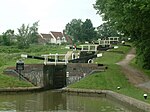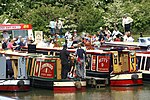St Peter & St Paul's Church, Watford

St Peter & St Paul's Church is an Anglican Church and the parish church of Watford, Northamptonshire. It is a Grade I listed building and stands on the west side of the Church Street. There is no reference to a church or priest in the entry for Watford in the Domesday Book.The main structure of the present building was erected in the 14th and 15th centuries, with further work in the 18th and 19th centuries. The church now consists of a nave, north and south aisles, chancel with north chapel, north and south porches and a west tower. A detailed description appears on the Historic England website.The parish registers survive from 1565, the historic registers being deposited at Northamptonshire Record Office.Watford is part of a united Benefice along with Long Buckby, West Haddon and Winwick. Each parish retains its own church building.
Excerpt from the Wikipedia article St Peter & St Paul's Church, Watford (License: CC BY-SA 3.0, Authors, Images).St Peter & St Paul's Church, Watford
Church Street,
Geographical coordinates (GPS) Address External links Nearby Places Show on map
Geographical coordinates (GPS)
| Latitude | Longitude |
|---|---|
| N 52.3161 ° | E -1.1164 ° |
Address
St Peter & St Paul Church
Church Street
NN6 7UR , Watford
England, United Kingdom
Open on Google Maps









